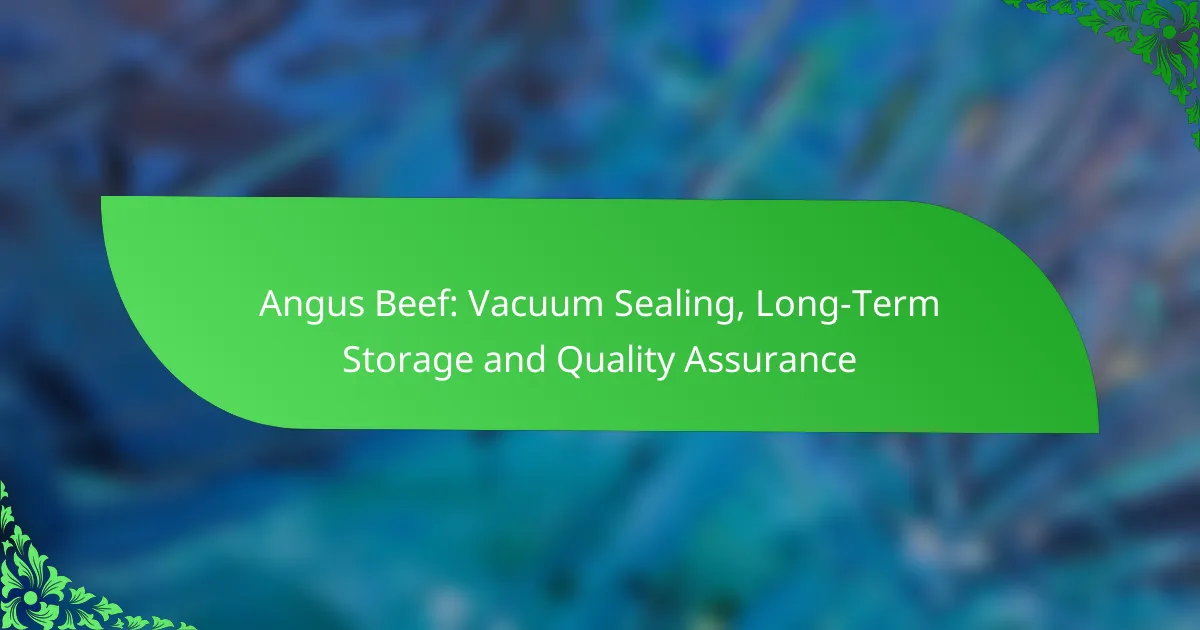Vacuum sealing Angus beef is an effective technique for preserving its quality during long-term storage. By removing air from the packaging, this method prevents freezer burn and significantly extends the meat’s shelf life, ensuring prolonged freshness and enhanced quality. For optimal results, store vacuum-sealed Angus beef in the freezer to maintain its flavor and desirable characteristics over time.

How to vacuum seal Angus beef for long-term storage?
Vacuum sealing Angus beef is an effective method for preserving its quality during long-term storage. This process removes air from the packaging, which helps prevent freezer burn and extends the meat’s shelf life significantly.
Use a vacuum sealer machine
A vacuum sealer machine is essential for effectively sealing Angus beef. These machines create a tight seal by removing air and sealing the bag, which is crucial for maintaining freshness. Look for models with adjustable settings to accommodate different types of meat and packaging needs.
When using a vacuum sealer, ensure that the machine is clean and functioning properly to avoid contamination. Regular maintenance will help prolong the life of your equipment and ensure optimal performance.
Choose appropriate vacuum bags
Selecting the right vacuum bags is vital for preserving Angus beef. Use bags specifically designed for vacuum sealing, as they are thicker and more durable than standard plastic bags. This prevents punctures and tears during storage.
Consider using bags that are BPA-free and approved for food storage to ensure safety. Some bags are designed for sous vide cooking, which can also be a great option if you plan to cook the beef directly from the sealed package.
Ensure proper sealing technique
Proper sealing technique is crucial for effective vacuum sealing. Place the Angus beef in the bag, leaving enough space at the top for the sealer to create a tight seal. Avoid overfilling the bag, as this can lead to air pockets and compromised seals.
When sealing, ensure that the bag’s opening is clean and free of any moisture or debris. This will help achieve a strong seal and prevent air from entering the bag, which can spoil the meat.
Label packages with date
Labeling vacuum-sealed packages with the date is an important step for tracking freshness. Use a permanent marker or label maker to clearly indicate the date of sealing on each package. This will help you manage your inventory and ensure that you use the oldest packages first.
Consider including additional information such as the cut of meat or any marinating details. This can be useful for meal planning and ensuring that you enjoy your Angus beef at its best quality.

What are the benefits of vacuum sealing Angus beef?
Vacuum sealing Angus beef offers numerous advantages, including prolonged freshness and enhanced quality during storage. This method effectively reduces spoilage and maintains the meat’s desirable characteristics over time.
Extended shelf life
Vacuum sealing significantly extends the shelf life of Angus beef by removing air, which slows down the growth of bacteria and mold. When properly sealed, beef can last several months in the freezer compared to just a few weeks in conventional packaging.
For optimal results, ensure that the vacuum seal is airtight and check for any punctures or leaks. Regularly inspect the stored beef to maintain quality and safety.
Prevention of freezer burn
Freezer burn occurs when air reaches the surface of the meat, causing dehydration and off-flavors. Vacuum sealing eliminates this risk by creating a barrier against air exposure, preserving the beef’s texture and appearance.
To further prevent freezer burn, store vacuum-sealed Angus beef in a consistent, cold freezer environment, ideally at or below -18°C (0°F). Avoid frequent temperature fluctuations by minimizing door openings.
Retention of flavor and moisture
Vacuum sealing helps retain the natural flavor and moisture of Angus beef, making it more enjoyable to eat after thawing. The absence of air prevents oxidation, which can lead to flavor degradation over time.
To maximize flavor retention, consider marinating the beef before sealing. This allows the marinade to infuse the meat deeply, enhancing taste while it is stored.

How to store vacuum-sealed Angus beef?
To effectively store vacuum-sealed Angus beef, keep it in a freezer for long-term preservation. This method helps maintain its quality and flavor while preventing freezer burn.
Store in a freezer
Freezing is the best option for long-term storage of vacuum-sealed Angus beef. Ideally, set your freezer temperature to 0°F (-18°C) or lower to ensure the meat remains safe and retains its quality. Vacuum-sealed beef can last several months in the freezer without significant loss of flavor or texture.
For best results, use a dedicated freezer rather than a refrigerator-freezer combination, as the latter may not maintain consistent low temperatures.
Maintain consistent temperature
Maintaining a consistent temperature is crucial for preserving the quality of vacuum-sealed Angus beef. Fluctuations in temperature can lead to freezer burn and spoilage. Regularly check the freezer’s temperature and avoid frequently opening the door to keep the cold air inside.
If your freezer has a temperature alarm, consider using it to alert you of any temperature changes that could affect the meat’s quality.
Organize for easy access
Organizing your freezer can help you easily access vacuum-sealed Angus beef without disrupting the cold environment. Label packages with the date of freezing and type of meat to ensure you use older items first. Consider using bins or baskets to separate different types of meat for quick retrieval.
A simple inventory list on the freezer door can also help you keep track of what you have stored, making meal planning more efficient.

What quality assurance measures are needed for Angus beef?
Quality assurance for Angus beef involves sourcing from reliable suppliers, verifying USDA grading, and inspecting packaging integrity. These measures ensure that the beef meets high standards for safety, flavor, and overall quality.
Source from reputable suppliers
Choosing Angus beef from reputable suppliers is crucial for quality assurance. Look for suppliers who have a strong track record and positive reviews, as well as those who adhere to industry standards for meat production.
Consider local farms or well-known brands that emphasize sustainable practices and animal welfare. This not only supports quality but also promotes ethical sourcing.
Check for USDA grading
USDA grading is an essential measure of beef quality, indicating factors like marbling and tenderness. Angus beef is typically graded as Choice or Prime, with Prime being the highest quality.
When purchasing, check for the USDA seal on packaging. This ensures that the beef has been evaluated and meets specific quality standards, providing assurance of its taste and texture.
Inspect packaging integrity
Inspecting the packaging of Angus beef is vital for ensuring freshness and safety. Look for any signs of damage, such as tears or leaks, which could compromise the meat’s quality.
Additionally, check the sell-by date to ensure the product is still within its freshness window. Properly sealed packaging helps prevent contamination and maintains the beef’s flavor and texture during storage.

What are the best practices for thawing Angus beef?
The best practices for thawing Angus beef involve methods that maintain quality and safety. Proper thawing prevents bacterial growth and preserves the meat’s texture and flavor.
Thaw in the refrigerator
Thawing Angus beef in the refrigerator is the safest method, as it keeps the meat at a consistent, cool temperature. This process can take several hours to a day, depending on the size of the cut. For example, a small steak may thaw overnight, while a larger roast could take up to 24 hours.
To ensure even thawing, place the beef on a plate or in a container to catch any juices that may leak. This method allows the meat to remain at a safe temperature, minimizing the risk of foodborne illness.
Use cold water immersion
Cold water immersion is a quicker alternative to refrigerator thawing. Submerge the vacuum-sealed Angus beef in cold water, changing the water every 30 minutes to maintain a low temperature. This method typically takes about one to three hours, depending on the size of the cut.
Ensure the beef is in a leak-proof bag to prevent water from entering and affecting the meat’s quality. This method is effective but requires more attention than refrigerator thawing.
Avoid microwave thawing
Microwave thawing is not recommended for Angus beef, as it can lead to uneven cooking and a loss of texture. Parts of the meat may begin to cook while others remain frozen, which can compromise flavor and safety.
If you must use a microwave, cook the beef immediately after thawing to prevent any bacteria from developing. However, for the best quality and taste, stick to refrigerator or cold water methods.
